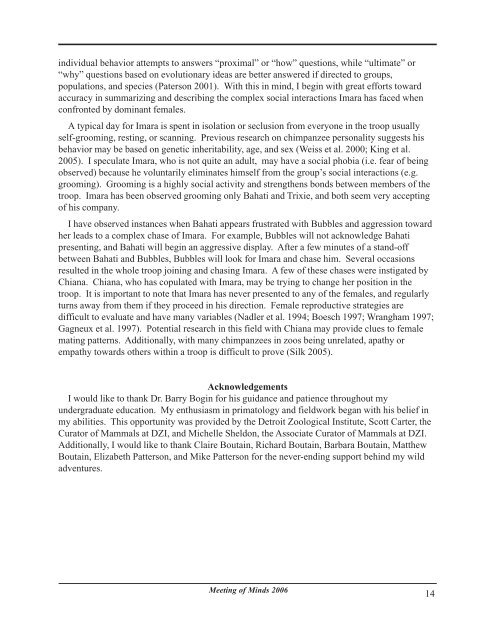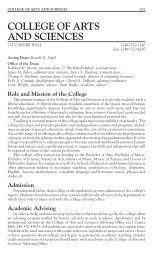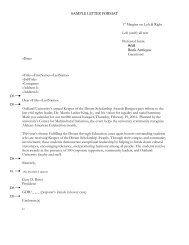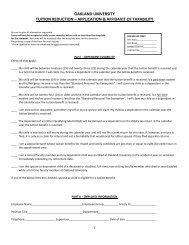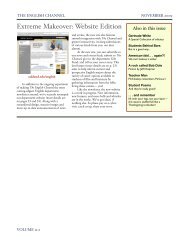MOM 2006 journal for pdf.pmd - University of Michigan-Flint
MOM 2006 journal for pdf.pmd - University of Michigan-Flint
MOM 2006 journal for pdf.pmd - University of Michigan-Flint
Create successful ePaper yourself
Turn your PDF publications into a flip-book with our unique Google optimized e-Paper software.
individual behavior attempts to answers “proximal” or “how” questions, while “ultimate” or<br />
“why” questions based on evolutionary ideas are better answered if directed to groups,<br />
populations, and species (Paterson 2001). With this in mind, I begin with great ef<strong>for</strong>ts toward<br />
accuracy in summarizing and describing the complex social interactions Imara has faced when<br />
confronted by dominant females.<br />
A typical day <strong>for</strong> Imara is spent in isolation or seclusion from everyone in the troop usually<br />
self-grooming, resting, or scanning. Previous research on chimpanzee personality suggests his<br />
behavior may be based on genetic inheritability, age, and sex (Weiss et al. 2000; King et al.<br />
2005). I speculate Imara, who is not quite an adult, may have a social phobia (i.e. fear <strong>of</strong> being<br />
observed) because he voluntarily eliminates himself from the group’s social interactions (e.g.<br />
grooming). Grooming is a highly social activity and strengthens bonds between members <strong>of</strong> the<br />
troop. Imara has been observed grooming only Bahati and Trixie, and both seem very accepting<br />
<strong>of</strong> his company.<br />
I have observed instances when Bahati appears frustrated with Bubbles and aggression toward<br />
her leads to a complex chase <strong>of</strong> Imara. For example, Bubbles will not acknowledge Bahati<br />
presenting, and Bahati will begin an aggressive display. After a few minutes <strong>of</strong> a stand-<strong>of</strong>f<br />
between Bahati and Bubbles, Bubbles will look <strong>for</strong> Imara and chase him. Several occasions<br />
resulted in the whole troop joining and chasing Imara. A few <strong>of</strong> these chases were instigated by<br />
Chiana. Chiana, who has copulated with Imara, may be trying to change her position in the<br />
troop. It is important to note that Imara has never presented to any <strong>of</strong> the females, and regularly<br />
turns away from them if they proceed in his direction. Female reproductive strategies are<br />
difficult to evaluate and have many variables (Nadler et al. 1994; Boesch 1997; Wrangham 1997;<br />
Gagneux et al. 1997). Potential research in this field with Chiana may provide clues to female<br />
mating patterns. Additionally, with many chimpanzees in zoos being unrelated, apathy or<br />
empathy towards others within a troop is difficult to prove (Silk 2005).<br />
Acknowledgements<br />
I would like to thank Dr. Barry Bogin <strong>for</strong> his guidance and patience throughout my<br />
undergraduate education. My enthusiasm in primatology and fieldwork began with his belief in<br />
my abilities. This opportunity was provided by the Detroit Zoological Institute, Scott Carter, the<br />
Curator <strong>of</strong> Mammals at DZI, and Michelle Sheldon, the Associate Curator <strong>of</strong> Mammals at DZI.<br />
Additionally, I would like to thank Claire Boutain, Richard Boutain, Barbara Boutain, Matthew<br />
Boutain, Elizabeth Patterson, and Mike Patterson <strong>for</strong> the never-ending support behind my wild<br />
adventures.<br />
Meeting <strong>of</strong> Minds <strong>2006</strong><br />
14


